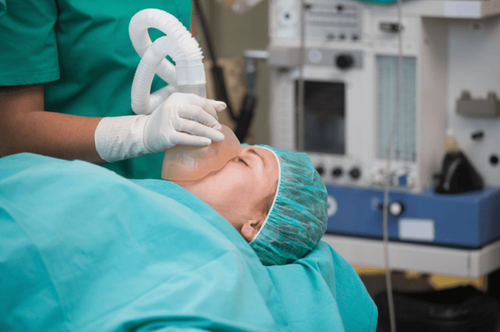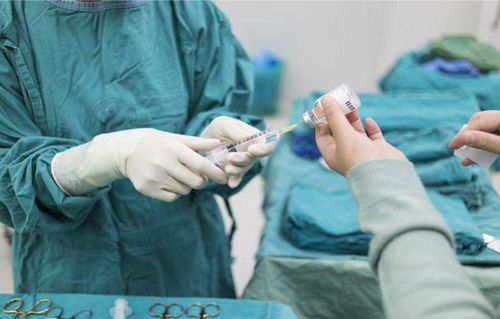This is an automatically translated article.
Pethistad 100mg drug has the main use of reducing moderate or severe pain, pre-anesthesia and enhancing anesthesia. The drug is often indicated for use when the pain is severe such as biliary colic, renal and ureteral colic, cardiac asthma, pulmonary edema due to acute left ventricular failure....
1. What is Pethistad 100mg?
Pethistad 100mg belongs to the group of pain relievers, antipyretics, non-steroid anti-inflammatory drugs, treatment of Gout and bone and joint diseases, used as directed and prescribed by a doctor.
The drug is prepared in the form of an injectable solution with the main ingredient being Pethidine Hydrochloride - 100mg, packed according to the specifications: Box of 10 tubes x 2ml.
Manufacturer information: Pymepharco Joint Stock Company - Vietnam.
Circulating in Vietnam with registration number: VD-23846-15.
2. Uses of Pethistad 100mg and mechanism of action
With the main ingredient is Pethidine Hydrochloride 100mg, Pethistad is effective in reducing pain, pre-anesthesia, enhancing anesthesia, depending on the condition and severity of the patient.
Pethistad 100mg works by the mechanism of action on the central nervous system at Opi receptors (used in spinal anesthesia). Pethidine injection, if used at a dose of 100mg, will give an analgesic effect equivalent to a 10mg dose of Morphine. If used for the purpose of maintaining the analgesic effect, it is often necessary to gradually increase the dose, because when using the drug with a frequency of many times or for a long time, there is often a phenomenon of familiarity with the drug.
3. Dosage and how to use Pethistad 100mg
Dosage and usage below are for reference only and can not completely replace instructions from a doctor. Some commonly used dosages are as follows:
Dosage for pain relief:
Adults take 25mg - 100mg, injected or orally. Intramuscular or intravenous injection with a dose of 25mg - 50mg very slowly, the dose is given 4 hours apart; Children: Use 1mg - 1.8mg/kg, orally or intramuscularly, once every 3-4 hours, a dose not exceeding 100mg. Pre-anesthesia dose:
Adults: Use 25mg-100mg intramuscularly at 1 hour before anesthesia; Children: 0.5mg - 2mg/kg IM 1 hour before anesthesia. Dosage to support anesthesia: Diluted Pethidine solution concentration is about 10mg/ml. The number of injections can be multiple doses spaced or can also be administered intravenously at a lower concentration (about 1mg/ml).
The drug can be used by mouth or by intramuscular or intravenous injection, depending on the indications from the doctor as well as the patient's condition. With each use, there will be the following notes:
For oral use, drink with about half a cup of water to ensure the solution is diluted, otherwise it will cause numbness of the oral mucosa; Intramuscular injection: Used in case of need to use the drug many times, when injecting should be large muscle injection and avoid the nerves; Intravenous injection: When injecting, it is necessary to inject very slowly, reduce the dose to a low dose and dilute the solution before injection. Always have antidotes, oxygen and respiratory support facilities ready to use as soon as unexpected problems occur; Use low doses and sparingly to avoid addiction.
4. Pethistad 100mg . side effects
With any drug or pharmaceutical product, it can cause unwanted side effects, depending on the extent that users should pay attention to have a suitable treatment plan.
Side effects of the drug include:
Manifestations of nausea may occur 20%, for patients with ADR; The risk of drug addiction is high, so it should be noted; Feeling dizzy; Urticaria on the skin; Respiratory depression, drowsiness or possibly fainting;
5. Drug interactions
When using Pethistad 100mg in combination with other products, there may be interactions that you need to pay attention to as follows:
Combined with Monoamine Oxidase Inhibitors (MAO): Causing coma, lowering blood pressure, depression severe breathing or possibly very dangerous cyanosis; Concomitant use of Scopolamine, Barbiturates and alcohol will increase the toxicity of Pethidine; Concomitant use of Cimetidine : Reduce the ability to eliminate Pethidine; Combined when using Furazolidone: Causes very high fever; Pethidine increases the production of toxic metabolites when used with Phenytoin If used concomitantly, intravenous injection of Pethidine is recommended. With any abnormal situation with the body, should immediately go to the nearest medical facility for examination and health monitoring. Do not arbitrarily handle or fix it without a prescription from a professional doctor.
6. Can pregnant and lactating women use Pethistad 100mg?
Pethidine should not be used by pregnant and lactating women. If required, the dosage for women during lactation can be balanced from 50mg to 100mg.
Pregnant women: Pethidine directly crosses the placenta. Morphine-type analgesics will inhibit breathing in the newborn, so they should not be given to the mother at 3-4 hours before birth. Long-term use can be addictive, and infants are also at risk for severe withdrawal symptoms. It is also possible to induce sinus tachycardia for the fetal heart when taking the drug during labor.
Lactating women: Pethidine will be excreted in small amounts into breast milk, causing premature breastfeeding delay because the drug can cause sleep.
The article has provided information about the uses, doses and precautions when using Pethistad 100mg. To ensure safety for your health and maximize the effectiveness of your treatment, you need to take Pethistad 100mg exactly as directed by your doctor.
Please dial HOTLINE for more information or register for an appointment HERE. Download MyVinmec app to make appointments faster and to manage your bookings easily.













